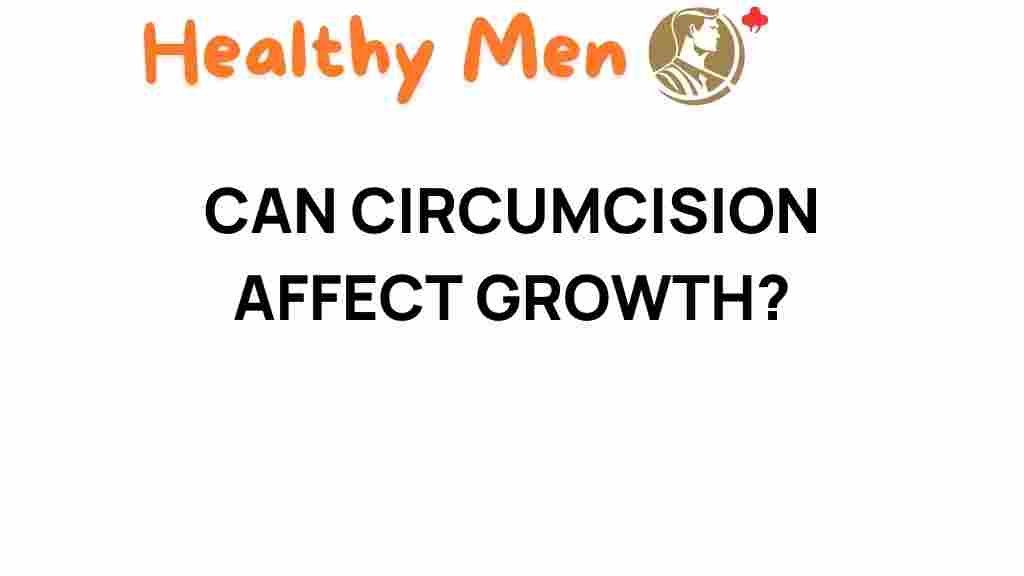Unveiling the Truth: Can Circumcision Influence Growth Rates?
Circumcision is a surgical procedure that involves the removal of the foreskin from the penis, a practice that has been a part of various cultures and religions for centuries. While circumcision has been associated with certain health benefits, its influence on growth rates and child development is a topic of ongoing debate. This article aims to explore the potential health effects of circumcision, particularly its impact on physical growth in children, by reviewing pediatric studies and medical research available on this subject.
Understanding Circumcision and Its Purpose
Circumcision is primarily performed for religious, cultural, or medical reasons. The main objectives of this procedure include:
- Reducing the risk of urinary tract infections (UTIs) in infants.
- Decreasing the risk of sexually transmitted infections (STIs) later in life.
- Preventing certain medical conditions, such as phimosis or balanitis.
- Adhering to cultural or religious practices.
The Link Between Circumcision and Growth Rates
When discussing the influence of circumcision on growth rates, it’s essential to consider various factors that contribute to a child’s physical development. Growth rates in children are influenced by genetics, nutrition, environment, and overall health. The question arises: does circumcision play a role in this complex interplay?
Several pediatric studies have examined the health effects of circumcision, but direct evidence linking circumcision to altered growth rates remains limited. Some key points to consider include:
- Circumcision itself is not a determinant of growth rates; rather, it may impact health outcomes that indirectly affect growth.
- Infections or complications resulting from circumcision could potentially hinder growth if they lead to significant health issues.
- Positive health benefits associated with circumcision, such as a reduced risk of UTIs, may promote better overall health, indirectly supporting optimal growth.
Insights from Medical Research
Numerous studies have attempted to assess the health effects of circumcision. A few notable findings from medical research include:
- A study published in the Journal of Urology indicated that circumcision significantly reduces the risk of UTIs during infancy.
- Research in Pediatrics suggests that circumcision may lower the incidence of STIs, which can have long-term health implications.
- A systematic review in the American Academy of Pediatrics concluded that the health benefits of circumcision outweigh the risks, especially in certain populations.
Evaluating Child Development and Circumcision
Child development is a multifaceted process involving physical, emotional, and cognitive growth. While circumcision is primarily a physical surgical procedure, its implications for child development are worth exploring:
1. **Physical Growth:** As discussed, circumcision itself does not influence growth rates directly. However, the overall health of a child, which can be affected by surgical complications or infections, may play a role in physical development.
2. **Emotional Impact:** Some studies have suggested that circumcision may have psychological effects on children, particularly if the procedure is performed without adequate pain relief. Emotional well-being can impact overall development, including growth.
3. **Social Factors:** Cultural and religious beliefs surrounding circumcision can affect a child’s social interactions and self-esteem, potentially influencing their development.
Potential Risks and Complications of Circumcision
Like any surgical procedure, circumcision carries risks. Understanding these risks is crucial for parents considering the procedure for their child:
- Infection at the surgical site.
- Excessive bleeding.
- Injury to the penis.
- Psychological effects related to the procedure.
While these risks are relatively rare, they can have significant implications for a child’s health and may temporarily affect growth rates, particularly in the context of recovery and infection management.
Step-by-Step Process of Circumcision
For parents considering circumcision, understanding the process can help alleviate concerns:
- Consultation: Discuss with a pediatrician or urologist to understand the benefits and risks.
- Preparation: The child may need to be fasting before the procedure.
- Anesthesia: Local or general anesthesia is administered to minimize pain.
- The Procedure: The foreskin is removed using various surgical techniques, typically lasting 30 minutes to an hour.
- Recovery: Aftercare involves proper cleaning and monitoring for any signs of infection.
Troubleshooting Tips for Parents
After circumcision, parents should be vigilant and know how to address potential issues:
- Monitor for Signs of Infection: Redness, swelling, or discharge should prompt a call to the pediatrician.
- Pain Management: Over-the-counter pain relief, as advised by a doctor, can help manage discomfort.
- Follow-Up Care: Attend all scheduled follow-up appointments to ensure proper healing.
- Educate on Care: Teach the child about genital hygiene to prevent infections.
Conclusion
In conclusion, the relationship between circumcision and growth rates is complex and multifaceted. While circumcision does not directly influence physical growth, its health effects can indirectly impact a child’s development. The procedure carries risks that parents must consider, and the decision to circumcise should be made based on a thorough understanding of the potential benefits and complications.
Ultimately, ongoing medical research and pediatric studies will continue to shed light on the implications of circumcision for male health and child development. As always, parents should consult qualified healthcare professionals when making decisions about surgical procedures for their children.
For more information on child health and wellness, you may visit CDC’s Children’s Health page.
This article is in the category Conditions and created by healthymen Team
